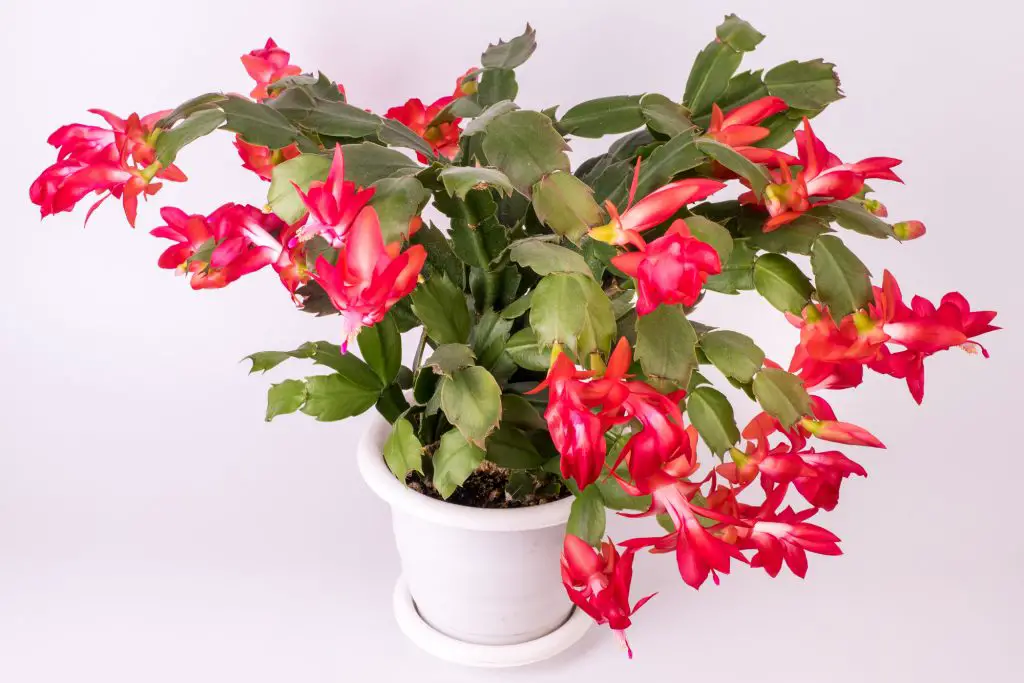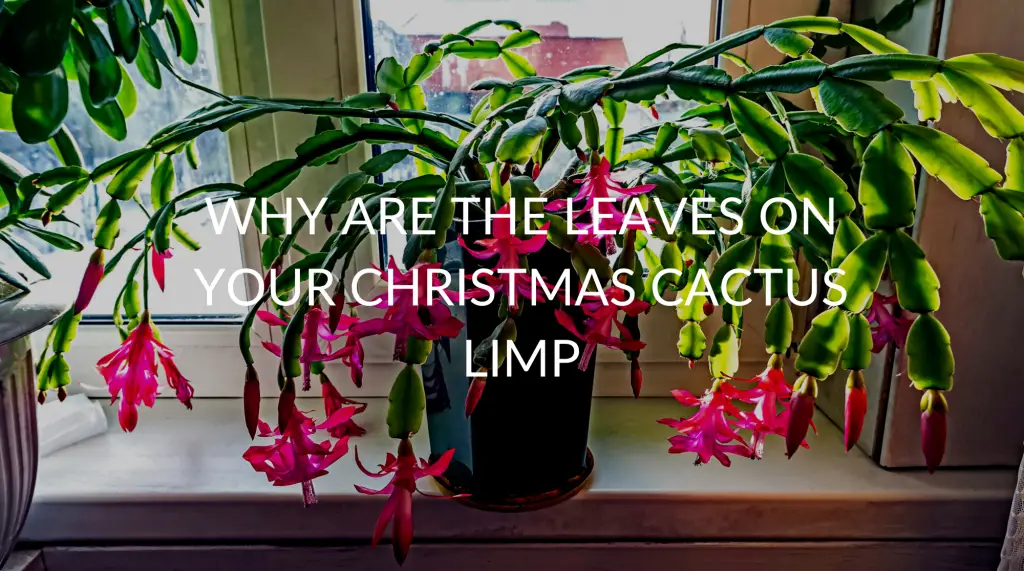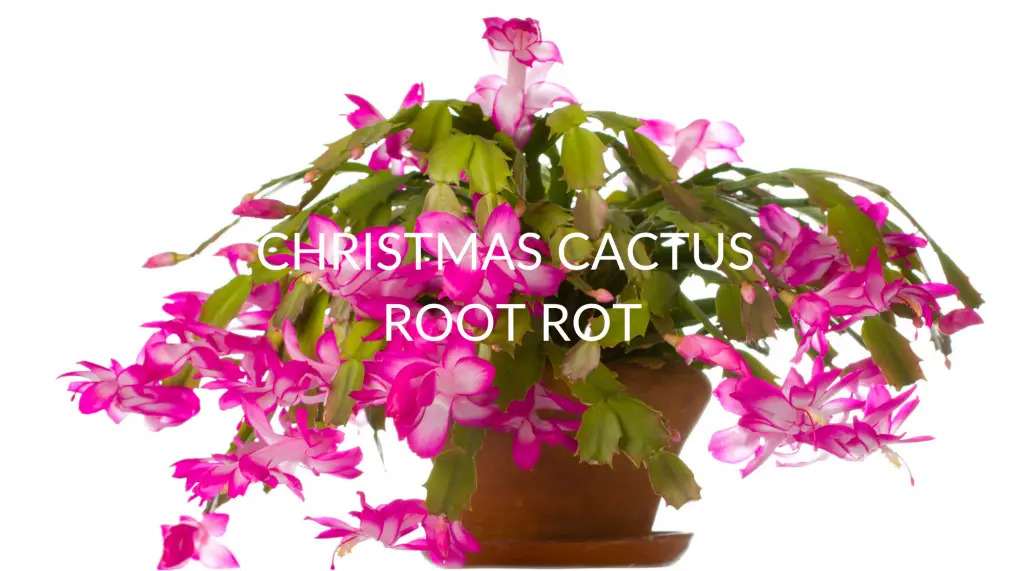Have you ever wondered when you should stop watering a Christmas Cactus to encourage flowering and make sure your plant stays happy and healthy?
In general, you should stop watering a Christmas Cactus around October, and just after the plant has flowered. The plant will not need any water for about 6 weeks after it has flowered.
In this article, we’re going to find out all there is to know about watering a Christmas cactus to make sure it flowers well and stays healthy throughout the year.

How To Water Christmas Cactus
If you’ve recently bought or been given a Christmas Cactus, it’s important to know how to look after it and when it needs to be given water. If you don’t have this understanding, you’re very likely to kill your plant in just a few weeks.
Step 1) Make Sure The Pot Has Drainage
Before you water your Christmas Cactus for the first time, you should make sure that the container it is in has some good drainage holes. Without drainage, you can’t water the plant, because the water will sit around its roots and it will quickly start to rot and die.
Lift the pot up and inspect the underside to make sure there are drainage holes there; if there are no holes, you will need to repot the Christmas Cactus into another container that has holes.
Step 2) Check If The Soil Is Dry
If the container is suitable, you should next make sure that the soil is dry enough to indicate that the plant needs water. You should not do this just by touching the top of the soil, however, because the layers below may be wet long after the surface has dried out.
You therefore need to push your finger to about 2 or 3 centimeters below the surface, and feel for moisture there; if the soil is dry, the plant is ready for a drink.
Step 3) Water The Cactus
You should water the Christmas Cactus thoroughly, soaking it until you see water coming out of the drainage holes at the bottom of the pot. This ensures that the plant’s roots have gotten wet, and the water isn’t sitting in the top of the pot for any reason. Light watering is not particularly good for most plants, including the Christmas Cactus.
Step 4) Remove Excess Water
Allow your cactus to drain for about 10 to 15 minutes, so that all the excess water has had time to run through the pot. The soil will still be damp, but the extra water will all have drained out and into the saucer below the plant by this time.
At this point, take the saucer and empty it out: you don’t want the plant’s pot to be sitting in a pool of water, as this will increase the chance of the cactus’s roots rotting.
Step 5) Wait Until It Next Needs Water
Now, wait until the plant needs watering again. Depending on your climate, this may be 3 to 5 weeks, although in very dry places, it may not be quite this long. Remember that these cacti do not need or like a lot of water, so you should be cautious about how much you offer.
How Often Does A Christmas Cactus Need To Be Watered?
This is heavily dependent on your climate, because the ambient humidity will make a big difference in how quickly your plant dries out. It also depends on the size of the pot and the size of the plant, how much sunlight the plant gets, and what sort of potting medium you have used.
However, a safe estimate is that you should check on the plant every 2 to 3 weeks, and aim to water it every 3 to 5 weeks. If you find that it is drying out much faster than expected, you can increase this, but make sure you aren’t overwatering it.
Small plants tend to need more frequent watering because their soil will dry out more quickly. A larger plant may need more water overall, but its pot should also hold more water, so you can give it a drink less frequently.
When To Stop Watering Christmas Cactus
You should stop watering a Christmas Cactus in October, when the weather starts to get cold. This drying of the soil will start encouraging the Christmas Cactus to stop focusing on growing foliage, and start focusing on the production of flowers.
You can lightly water the Christmas Cactus through November if you want to, but make sure you are only adding a little water to the pot to prevent the roots from becoming completely dry. This will continue to encourage the plant to bloom. Water lightly while it is in flower, as over-watering could cause the buds to fall off.
When the plant has finished flowering, you should again stop watering it. This encourages the plant to rest, and it shouldn’t be watered again for about 6 weeks after it has finished flowering.
How Do I Know If I’m Over Watering My Christmas Cactus?
There are a few things that will let you know if you are overwatering your Christmas Cactus. Overwatering can kill this plant, so make sure you are looking out for the below signs. If you see any of them, you will need to quickly repot your cactus into dry soil if you are to have any hope of saving it.
Sign 1) Limp Or Falling Leaves
If the foliage of your Christmas Cactus is starting to look limp, it’s a sure sign you are overwatering it, or that it has got too dry. Check the soil, and if the soil is wet, you have overwatered the plant.

Sign 2) Mushy Stems
Being watered too heavily will cause the plant to rot, and one of the first signs of this is the stems turning mushy. If you notice that the stems are dark or soft to the touch, there’s a high chance your plant has had too much water.
Sign 3) A Bad Smell
Overwatering causes bacteria and fungus to spread in the plant’s soil, and this will sometimes create a bad odor when you move the plant around. If you notice that your cactus smells of rot, you should immediately check whether it has been watered too heavily.
Sign 4) Flower Loss
If your Christmas Cactus is in flower and it keeps dropping its buds, this indicates you are watering it too much. Bud drop can happen for other reasons too, but excessive moisture is a common problem.
Sign 5) Root Rot
The surest way to tell whether a cactus has been overwatered is to remove it from its container and inspect its roots. If they are firm and white, the cactus is fine, but if they have turned mushy, brown, or black, the plant is rotting. Depending on how bad the root rot is, you may not be able to save it.

Sign 6) Yellow Leaves
If your plant’s leaves seem to be tinged with yellow around the edges and you can’t figure out what’s wrong, there’s a high chance you’ve given it too much water. This happens when the roots start rotting, because your cactus can no longer absorb the nutrients needed to make bright green foliage.
Yellow leaves are more commonly caused by too much water than by anything else, so watch out for this and take it as a sign you need to give your plant less to drink in the future.
Sign 7) The Leaves Have Brown Spots
A further sign to be aware of is brown or black spots appearing on the leaves, as these indicate that the tissues inside the leaves are starting to rot. If you touch them and they are mushy, you have certainly over-watered your Christmas Cactus, and you will need to repot it if you are to save it.
This can be accompanied by yellowing and limpness, so look out for a combination of these signs, rather than one in isolation.
How To Care For A Christmas Cactus Houseplant
As well as watering the plant correctly, there are other things you need to do to keep it healthy. Understanding your plant’s needs gives it the best possible chances of thriving in your care.
Tip 1) Give It The Right Amount Of Light
Christmas Cacti like a reasonable amount of bright light, but they are not fond of direct sun, and there is a risk that this will burn their leaves and eventually kill them if they are exposed to it for too long. You should put your Christmas Cactus on a windowsill that faces north, or provide some shade to filter out the brightest of the sun’s rays.
Christmas Cacti will tolerate low light conditions, but they are less likely to flower if they don’t get any sun, so make sure you are providing at least some sunlight each day to encourage your plant to produce those attractive blooms.
Tip 2) Give It The Right Amount Of Food
Like all plants, Christmas Cacti need nutrients in their soil as well as a good amount of sunlight if they are to grow strong and healthy. You can give your plant a diluted houseplant fertilizer every couple of weeks, or less frequently, and this should encourage it to produce lots of new growth.
When the plant is starting to flower, GoodHouseKeeping recommends that you swap to a fertilizer that is high in potassium, as this may encourage more buds to form.
Tip 3) Repot It When Necessary
Christmas Cacti prefer to have slightly crowded roots, but you will still need to repot your plant from time to time, or there is a risk that it will get pot bound and start to die from lack of oxygen and nutrients.
Repot your Christmas Cactus as soon as it finishes blooming, before it starts to produce new growth (about 6 weeks later) to minimize the disruption and keep the plant happy. It will usually need repotting every 3 or 4 years, and requires fresh soil and a slightly larger pot when this time arrives.
Tip 4) Keep It Warm Enough
A Christmas Cactus prefers to be kept at around 65 degrees F, and it will struggle if the temperatures drop lower than this. That means you need to make sure you keep the cactus away from cold windowsills and drafty rooms when winter hits, or you might notice its leaves starting to blacken and curl.
On the flip side, don’t put your Christmas Cactus on a heater; although these plants come from desert regions, a radiator produces far too much heat and will kill the plant in just a few short hours.
Tip 5) Use The Correct Potting Medium
It’s important to make sure your Christmas Cactus can drain properly, so whenever you put this plant in a new pot, you’ll need to give it the correct potting medium – a mixture of sand and regular soil.
You usually want about 2/3 regular soil and 1/3 sand, although you can also use commercial cactus mixes, succulent mixes, or bromeliad mixes. Make sure the drainage is good enough before you move your cactus into the soil, because it will struggle to grow if the soil is too wet.
Tip 6) Check The Humidity
Christmas Cacti like to be kept fairly humid, so it’s a good idea to occasionally mist around the plant if the air is very dry, especially in winter, when you may have your heating system on (which makes the house drier).
You can also create a pebble tray by filling a shallow bowl with pebbles and topping it up with water to just below the surface of the pebbles. Place the cactus’s pot on the pebbles, and the water will evaporate and gradually humidify the plant.
FAQ
Q: Do you water Christmas Cactus while blooming?
A: Yes, according to the Almanac, you should water your Christmas Cactus while it is blooming, but more lightly and carefully than you would at other times of the year.
If you provide no water, the flowers will shrivel and die, but if you provide too much, there is a risk of the young buds dropping off. Make sure you provide a little water whenever the soil appears dry to a couple of centimeters below the surface.
Q: When should you put a Christmas Cactus in the dark?
A: If you want your cactus to flower, you should put it in a dark spot around later September, or possibly early October. You can move it to a dark room or simply cover it with a box, but make sure that it is getting 12 hours of uninterrupted darkness every day for at least 4 weeks prior to blooming.
This will encourage it to start producing flowers, and if you don’t put it in the darkness, it will simply continue producing foliage throughout the year.
Q: What should you do if you have overwatered your Christmas Cactus?
A: If you’ve given your plant too much to drink, you will need to quickly tip it out of its container and wash the soil off its roots. Use sterile scissors to trim off the rotting roots and gently dry the healthy ones with some clean kitchen towel, and then leave them to air dry.
Repot the plant into a new container with completely fresh potting medium, and there is a chance that it will recover, if its roots were not too badly damaged and you acted promptly.
Q: Can a Christmas Cactus go a month without water?
A: If it’s in a fairly damp location so the soil will not dry out too quickly, a Christmas Cactus could go for a month without water, but it will generally need watering slightly more often than once per month. You should be checking if it is dry at least once every 3 weeks, so stretching this to a month risks damaging the plant.
If you are going to be away for a month, consider whether you can have a neighbor drop in, or try one of the self-watering tricks that are available online to make sure your cactus is getting at least some water while you are gone.
Q: How many years does a Christmas Cactus live?
A: If you look after your plant well, CountryLiving says that it could live up to 100 years, which is pretty impressive. You will need to take very good care of it, however, so make sure you thoroughly familiarize yourself with its care requirements and you look after it.
Recap
You should stop watering a Christmas Cactus around October, and only start watering it again when it starts to flower. When it has finished flowering, do not water it for 6 weeks, and then resume your normal routine. Watch out for signs of overwatering, like yellow leaves and mushy stems.
Christmas Cacti are fun plants that are pretty easy to look after. They need light, fertilizer, and a fairly consistent temperature, but they are hardy and will create a stunning show of flowers for your holiday table.






